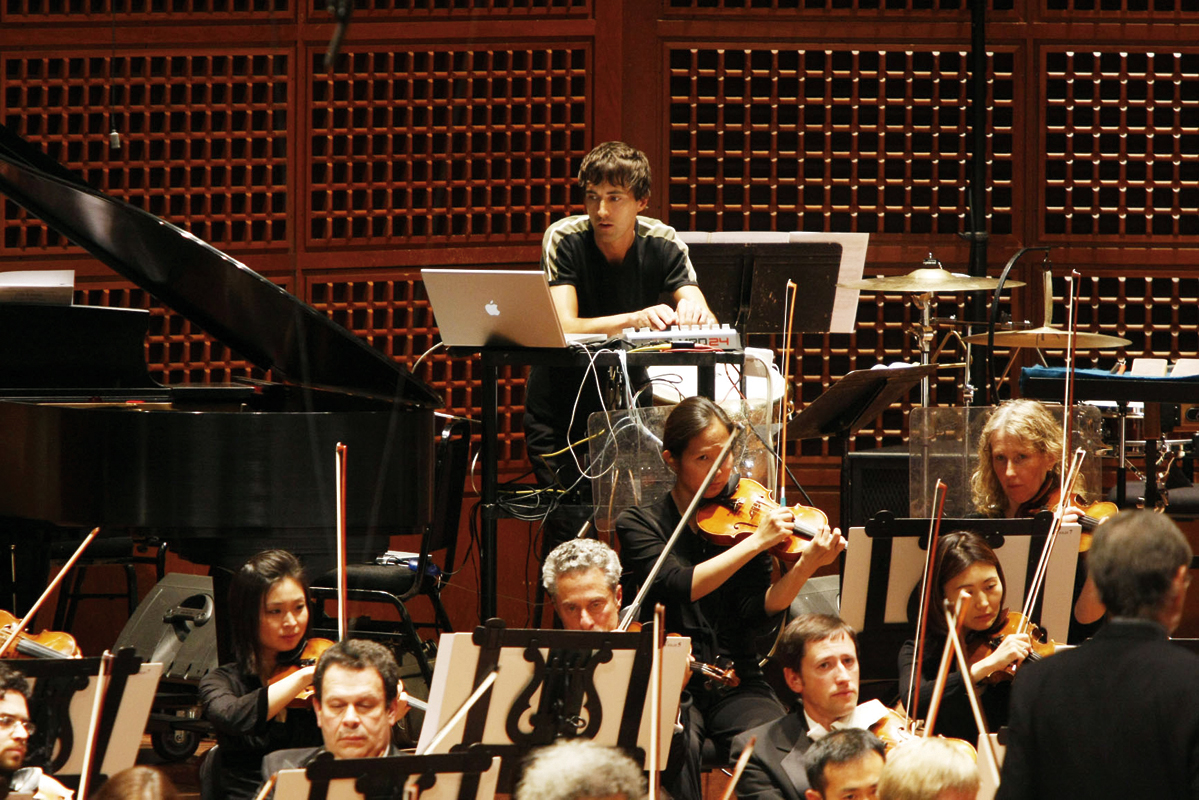With its first program of 2015, the Dallas Symphony Orchestra is venturing out of its (and some of its audience members’) comfort zone. This weekend, sandwiched between two beloved romantic staples (Rachmaninoff’s Rhapsody on a Theme of Paganini and Dvorák’s Seventh Symphony), the DSO is giving its first-ever performance of Mason Bates’ Liquid Interface, a mash-up of electronica-inspired beats, prerecorded sounds, jazzy melodies, and traditional symphonic timbres.
Bates, who was born in Richmond, Va., in 1977, is the Chicago Symphony’s composer-in-residence and has made a name for himself internationally as a highly innovative classical composer. He’s also a popular DJ in the Bay Area, where he appears regularly at clubs in San Francisco and Oakland under the name DJ Masonic. His symphonic compositions frequently draw on both of his musical identities, combining the digitized sounds and beats of electronica with sophisticated classical idioms. The result is a wholly unique aesthetic.
Composed in 2007, Liquid Interface is, according to Bates, “a water symphony that has electronic sounds that expand the orchestral palette.” In each of the work’s four movements (played without pause), water is referenced in a unique form. The work opens with the cold, titanic sounds of arctic glaciers calving. Emanating unaccompanied from speakers on either side of the stage, the sound of the ice creaking and moaning is powerful and immediately captivating. The music that follows is equally riveting, with busy instrumentation, rapidly unfolding themes, and seamlessly integrated digital and acoustic sounds.
A drum pad is used to manufacture beats from the sound of water droplets in the staccato-driven second movement. The climactic third movement samples Dixieland jazz and the whooshes and wails of water at its most violent, during a hurricane. Here images of New Orleans are summoned at first playfully, relying on a brass section that swings like a big band, then more fiercely, when Bates releases the sounds of the powerful storm. The final movement evokes the ephemeral qualities of water as vapor.
If you go to the symphony this weekend, you’ll see Bates, his head bopping up and down behind a laptop in the percussion section, looking every bit the DJ. In an interview earlier this week, Bates explained that this piece can easily be performed in his absence; he has worked hard to make sure that the digital components are accessible to any orchestra’s percussion section. But, he says, “what they would do [without me] is a little bit more like the Betty Crocker mix, whereas when I’m there, I’m mixing it live. It tends to be a little more flexible when I’m there, so it’s very special to be coming in and performing it with Dallas and Maestro van Zweden.”
On Thursday night, Bates, the DSO, and Jaap van Zweden pulled off a tight, energetic performance of Liquid Interface. While this performance was a first for the orchestra, van Zweden and Bates have performed this piece together before with the Chicago Symphony. “The thing that really bowled me over,” Bates said about working with van Zweden, “is that he not only has these incredible skills that you might expect from an old-world maestro, but he is also so nuanced with his interpretation of American music, and especially with electronics. He is very cool and very flexible when dealing with this new element. I feel like he’s a man that can sort of do anything.”
In the spirit of doing anything (and everything), this weekend’s program features three other works, all of which are big and climactic. The concert opens with Chávez’s Sinfonia India, a rhythmically complex, almost Coplandesque piece that serves as a sort of historical marker, honoring the DSO’s late music director, Eduardo Mata, who died in a plane crash 20 years ago and who conducted this same piece with the DSO during the orchestra’s first concert in the Meyerson Symphony Center in 1989. The orchestra’s performance Thursday night was festive and spirited.
Following the Chávez, 21-year-old piano virtuoso Conrad Tao, the orchestra’s new artist-in-residence, was soloist in an insanely fast-paced rendition of Rachmaninoff’s crowd-pleaser, Rhapsody on a Theme by Paganini. Tao’s technical skills are mesmerizing, but last night he seemed bent on proving that point by playing at unnecessarily high speeds. The orchestra, which is less nimble by nature, struggled to keep up with Tao at times, resulting in more than a few bumpy moments. During more relaxed sections, Tao and the orchestra generated some lovely, poetic duets, and van Zweden countered the frenetic tempo with unrushed pauses between each variation and thoughtful shaping of the work’s famous, romantic melody. At the end of the performance Thursday night, the crowd went wild, wowed by Tao’s virtuosity.
As if all of this weren’t enough, the orchestra followed Liquid Interface with a performance of Dvorák’s Symphony No. 7. There was a clarity to the playing during this piece that felt comfortable and recognizable. This is the DSO we know and love: passionate, articulate, and perfectly rehearsed.
If there is a problem with this weekend’s program, it is that it doesn’t really work as a cohesive whole. What any of these pieces have to do with one another is baffling. I love that the orchestra programmed a contemporary piece of music by an innovative composer, but they seem to not quite know how to do so thoughtfully. It would have made more sense to place Liquid Interface in some sort of aesthetic context, maybe alongside music by other American composers, or juxtaposed against classical works by Wagner or Debussy that also draw on aquatic imagery.
That being said, there was palpable energy in the room on Thursday evening, and it was the kind of spark that only comes from taking a risk and trying something new and different. If you’re typically bored by the DSO’s programming, don’t miss this chance to hear them stretch themselves all the way into the 21st century.






